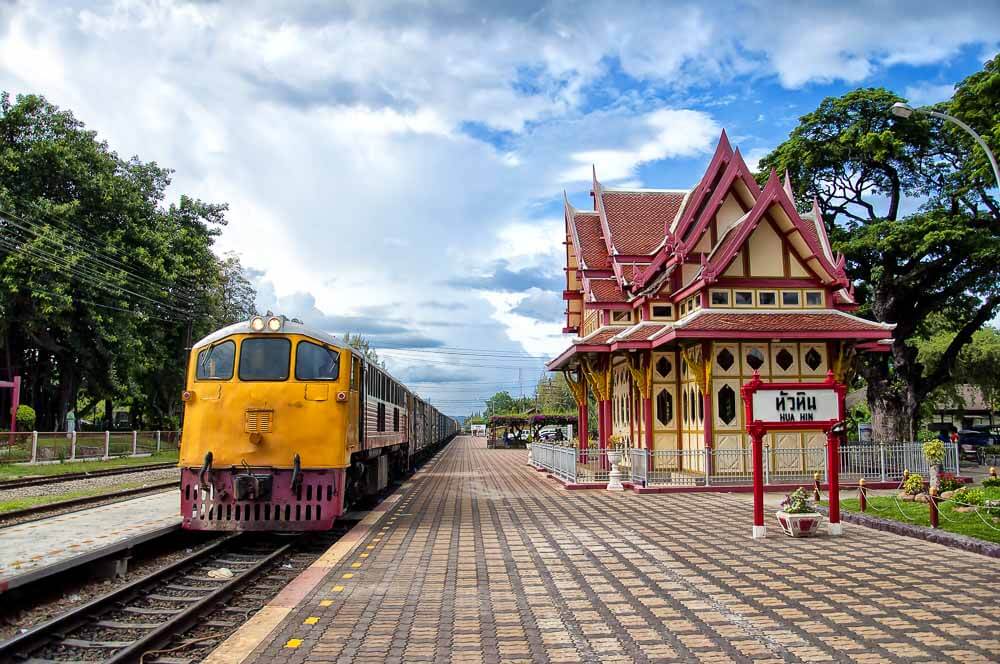
Located just three hours away from Bangkok, Hua Hin is a small seaside town offering incredible beaches and mountains to both foreigners and locals looking for a nice holiday destination.
Hua Hin was first discovered as a gateway holiday destination by King Rama VII in the 1920s. Since then, the coastal town has been developed into one of the most popular beach towns in the country. Unlike other places in Thailand, Hua Hin has retained its quiet and relaxing atmosphere, making it the perfect destination for families and couples looking for a relaxing weekend by the sea.
If you’re planning to visit Hua Hin, here is a comprehensive guide with information about the best times to visit Hua Hin, the best things to do in the town, and the great places to stay during your holiday.
Hua Hin has a subtropical climate with occasional temperature fluctuations. Being so close to the equator, Hua Hin experiences a very minimal difference in air and water temperatures over the course of the year, with temperatures ranging between 29 degrees to 33 degrees. Having said that, Hua Hin can experience small rain showers outside the actual rainy season.
From June to October, Hua Hin experiences light to heavy rainfall. During the rainy season, tourists rarely travel to the coastal town. However, this is a good time to visit Hua Hin if you’re looking for great deals on flights and hotels. Tickets for tourist destinations will also be at their lowest prices.
If you’re visiting Hua Hin during the rainy season, it is advised to pack a sturdy pair of shoes that can withstand beating the puddles.
The months of November to February are largely considered the best time to visit Hua Hin, particularly because the weather is pleasant and the days are sunny. As such, this is also the period where the town experiences an influx of tourists.
If you plan to visit Hua Hin during these months, it is better to book hotels and tickets months ahead. This not only ensures that you have a place to stay during your trip, but it also helps you save money and avoid soaring prices.
The months of March, April, and May are the hottest times of the year, with the sun constantly beating down. For many, the heat can become very uncomfortable. Having said that, many visitors still come to the coastal town to lounge on its many beaches or explore the surrounding nature and tourist sites.
If you plan to visit Hua Hin at this time, don’t forget to bring a bottle of sunscreen, sunglasses, and a hat.
The temperature in Hua Hin town during the peak tourist season ranges between 23 degrees to 31 degrees.
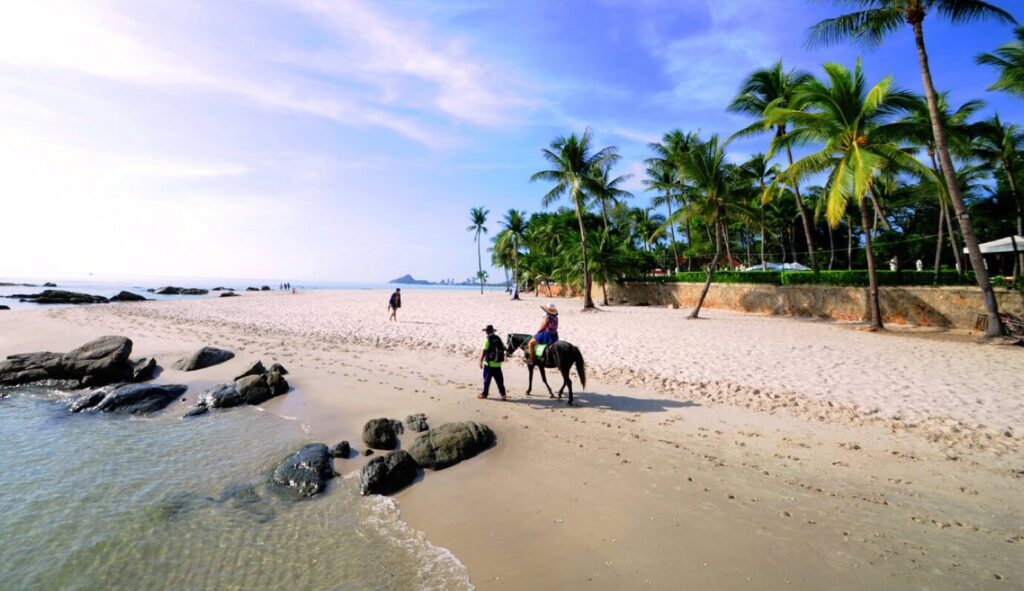
Hua Hin Food Festival
The King’s Birthday
Loy Krathong (Festival of Lights)
During the rainy days, the temperature ranges from a low of 26 degrees to a high of 32 degrees.
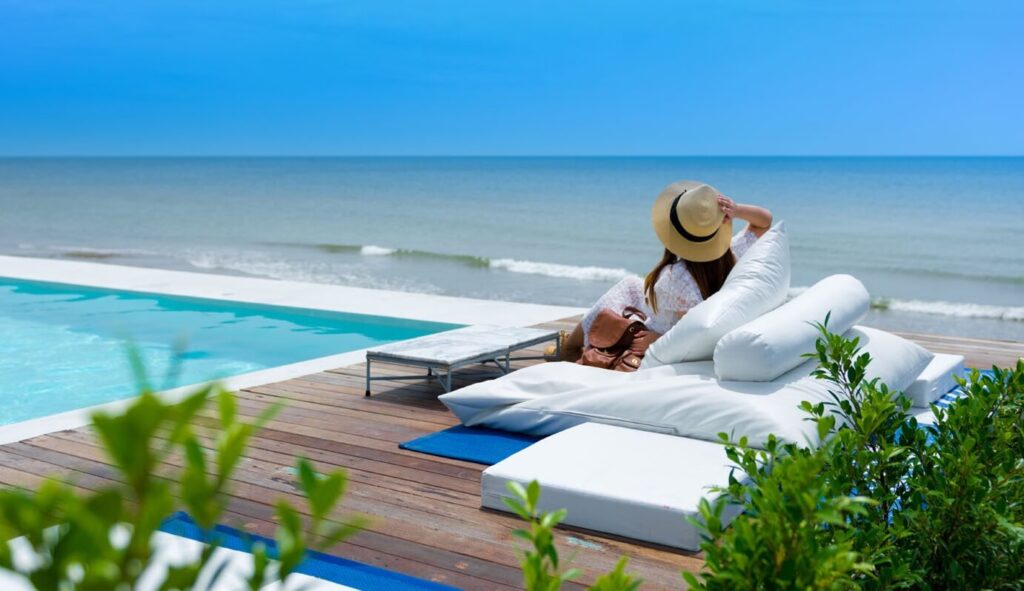
Key events:
Hua Hin is located approximately 90 miles south of the capital city of Bangkok, making it easier for tourists to travel between the two areas.
There are plenty of transportation options available from Bangkok to Hua Hin. First off, you would need to fly to Suvarnabhumi International Airport in Bangkok.
From Suvarnabhumi Airport
Once your flight lands in Bangkok, you can go to the service counter near Gate 8 to purchase tickets for a tourist bus to Hua Hin. The modern coaches, all of which are equipped with a toilet, seat 24 people each. Passengers are also given drinking water free of charge.
The bus to Hua Hin city departs Suvarnahubmi Airport eight times a day. The first coach departs Bangkok at 9 AM, and each bus goes every 1 hour and 30 minutes. Travel time from Bangkok to Hua Hin takes approximately 3 to 4 hours, but it could take longer during the peak season when traffic is heavy.
Bus tickets cost 340 Thai Baht (THB) per person. Each passenger is allowed to carry a 20-kg of luggage and a handbag that can fit in the overhead compartment. If you have more luggage, you may need to speak with staff members at the service counter about fees for additional storage.
From Bangkok City Centre
If you prefer to catch a bus to Hua Hin from Bangkok’s city centre, the coaches are stationed in Sai Tai Mai (Southern Bus Terminal). Getting to the bus station from the airport could be challenging as it’s not near a main BTS or MRT station. As such, tourists are advised to take a taxi to Sai Tai Mai.
There are plenty of buses at the Southern Bus Terminal, which ticket prices ranging from 200 THB to 300 THB, depending on whether it’s peak tourist season. To save up on prices, and ensure that you have a seat, book your tickets in advance.
*Buses leave Sai Tai Mai every 20 minutes.
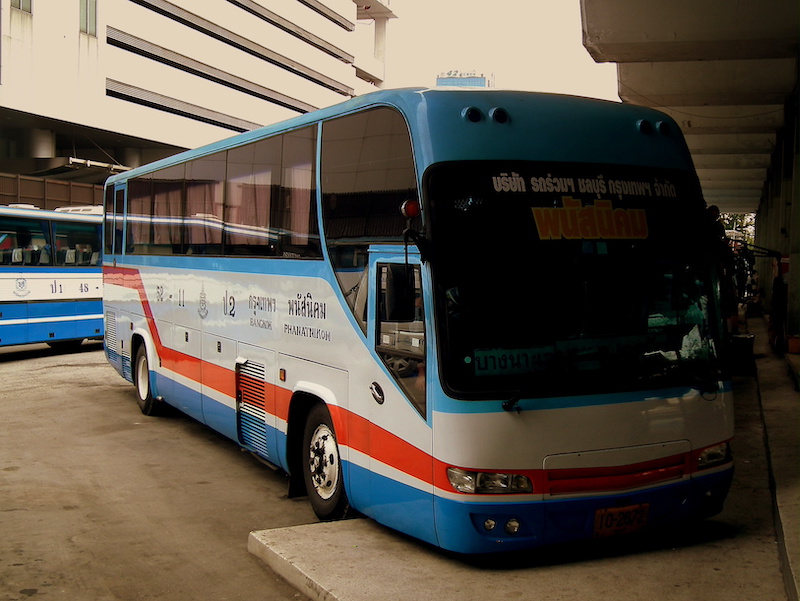
Travelling by train is a lot slower than other alternatives like buses and minivans. Trains may not need to pass through traffic, they are not always on time. However, it’s a great option if you want to travel the scenic route.
The Bangkok-Hua Hin train departs from the Hua Lamphong railway station from 8:05 AM to 8:50 PM. The journey takes about four hours.
There are three different train tickets you can purchase, with the cost varying depending on your chosen class.
Third-class Seats
Third-class seats are normally not airconditioned. Sets in third-class trains are also often filled with conscripts in the Thai military travelling back home during their leave.
The price of a third-class train ticket is approximately 150 THB.
Second-class Seats
Second-class trains offer padded chairs facing in the direction of the travel. Some trains can be transformed into upper and lower bunks during the nighttime, with lower bunks costing more than upper bunks.
Some second-class trains are cooled by fans and open windows, other second-class trains are air-conditioned. Tickets for second-class trains can cost approximately 400 THB.
First-class Seats
First-class trains are the best seat types available in Thailand’s train services. They are also the most expensive with ticket prices starting at 600 THB.
First-class tickets give guests separate compartments, most of which have two seats that can be transformed into bunk beds at night. First-class compartments have air-conditioning, lockable doors, sinks, electric sockets, bedside shelves, light switches, overhead storage spaces, pillows, and blankets.
Taxis are the most comfortable and convenient transportation option in Thailand. However, it’s also the most expensive.
You can hire a taxi from Bangkok to Hua Hin in three places.
First, there are taxi stands at the Suvarnabhumi Airport that offers cabs with a fixed price set per destination. A ride to Hua Hin can set you back around 3,000 THB.
Second, you can hire taxis in the city centre. That being said, make sure you negotiate and agree on a fare before the start of your trip. You can normally negotiate a deal as low as 2,000 THB to Hua Hin.
Lastly, there are private car companies that allow guests to book taxis online. However, car companies can charge between 3,000 to 3,500 THB for a three-hour trip to Hua Hin.
The cheapest and easiest way to get to Hua Hin is by minivan. The ticket price costs approximately 180 THB per head. Each minivan is equipped with air-conditioning and can seat 10 to 12 people.
Minivans depart from several locations, including Ekkamai, Khao San Road, and Mo Chit New Van Terminal. The travel time to Hua Hin takes about 3 to 4 hours, depending on the traffic.
While minivans are cheap, there are some drawbacks you should take into consideration.
Minivans have very limited space for both passengers and baggage. If you are carrying lots of luggage, you may be required to pay for an extra seat.
In addition, minivan drivers have deadlines to meet, which means they can drive too fast.
Getting around Hua Hin is fairly easy. The town is small enough to fully explore by bike or motorcycle, but reaching some places would likely require you to hire a songthaew. There are plenty of travel options in the city. Here’s a quick rundown.
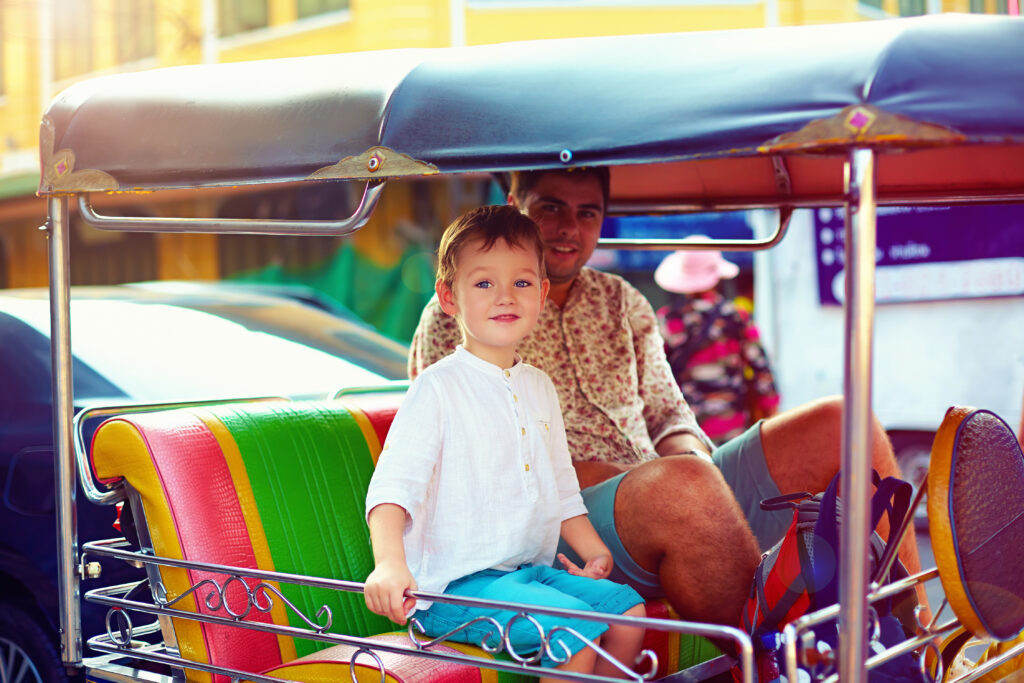
There are many tuk-tuks in Hua Hin, but they can be very expensive. Some drivers may not be willing to negotiate their rates and may charge tourists a “minimum fare” of 100 THB. As such, we advise you to only use tuk-tuks when you need to transport luggage.
A samlor, also known as a tricycle, generally refers to a pedal-driven vehicle. There are very few of these in Hua Hin because the work is hard. The remaining drivers are also as old as their vehicles.
If you’re hoping for a photo op, hiring a samlor would give you that postcard perfect picture you need. However, if you’re hiring one to get to your destination, don’t expect to get there very quickly, especially if it’s more than a few blocks away.
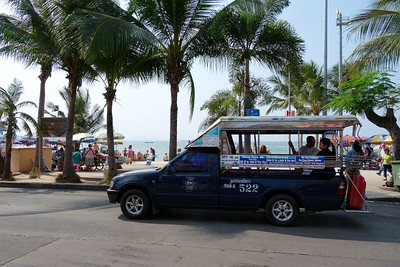
A songthaew is a pickup truck with two rows of seats in the back. A songthaew functions as a taxi and is one of the cheapest ways to get around Hua Hin, with fares starting at 10 THB per head.
Different coloured songthaews in Hua Hin operate along four fixed routes.

Motorcycle taxis are often reasonably priced, with trips starting at 20 THB per person. They are also easy to flag down because you’ll likely see motorcycle taxis on many of the city’s street corners. Motorcycle taxi drivers can be distinguished by their orange and purple jackets with numbers on the back and front.
Some things you have to remember before riding a motorcycle taxi are:
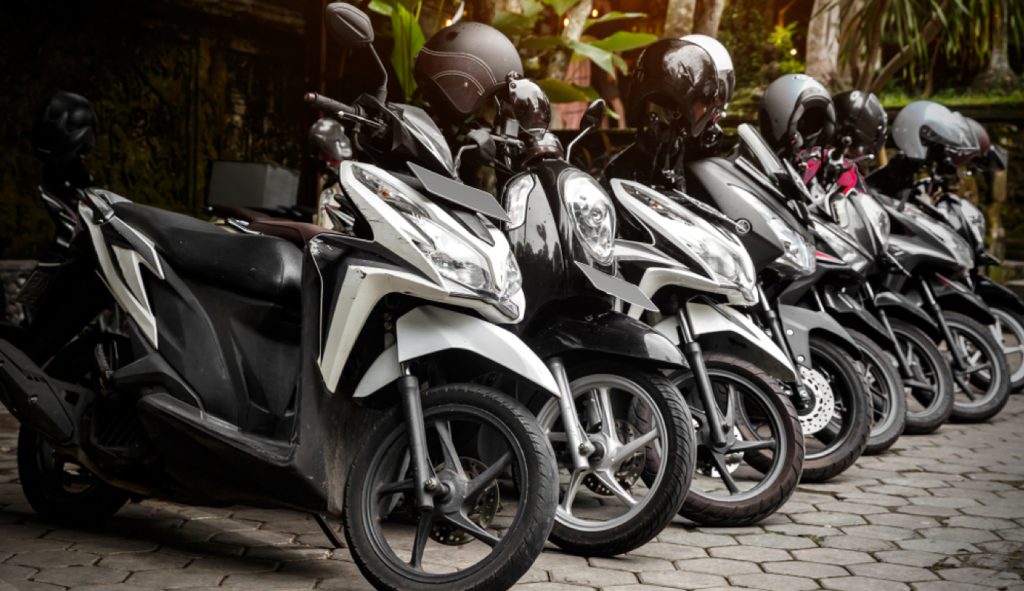
If you want more flexibility or you are planning on travelling to a lot of places, renting a motorbike can be the best option. There are plenty of motorbike rental shops around the city. Some hotels are also partnered with rental shops or offer rental bikes themselves. Do note that some stores would require you to have an international driving license to rent a motorbike.
Renting a motorbike may set you back about 150 to 200 THB per day
Hua Hin is a small town, especially compared to other cities in Thailand like Bangkok and Phuket. That being said, there is an incredible amount of hotels, guesthouses, resorts, and other accommodations located in town. While all of these options offer you a place to sleep, selecting the place to stay can make or break your vacation.
We’ve divided Hua Hin into several distinct areas with details about what you should expect, including which neighbourhood offers vibrant nightlife and which provides a refuge from all the hustle and bustle.
Jump to location
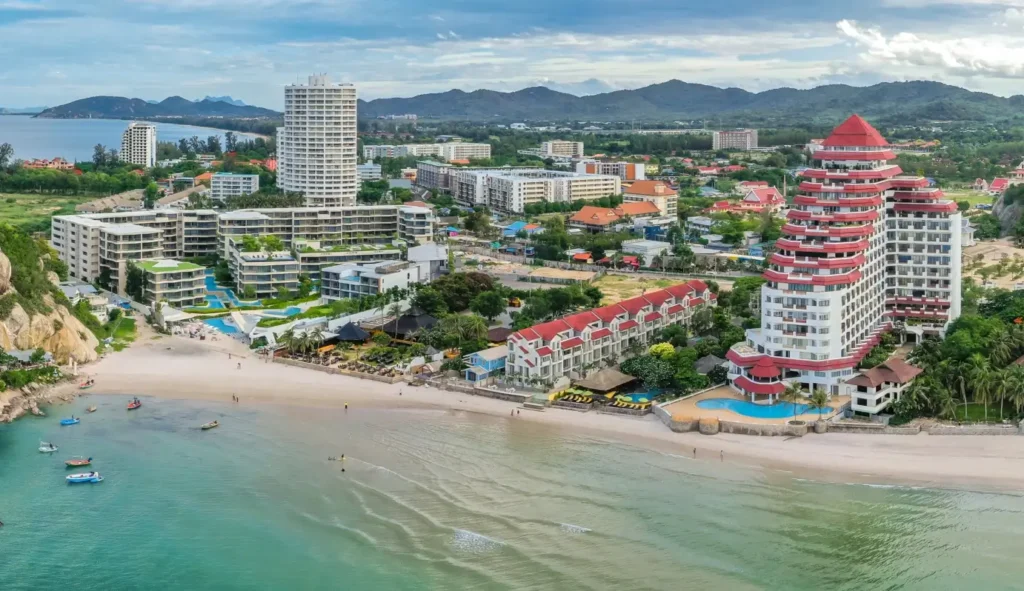
Khao Takiab, also known as the Monkey Mountain, is a small fishing village in southern Hua Hin that is popular with luxury travellers, families, and couples looking for relaxation. Most of the area’s beach is dominated by the mountain and Wat Khao Takiap, a Buddhist temple housing groups upon groups of monkeys and amazing views of the surrounding area.
Aside from Monkey Mountain, Khao Takiab is also famous for its weekend markets, most especially Cicada and Tamarind.
Cicada is an arts and handicrafts market that local artisans flock to every weekend to sell their hand-made wares, such as leather camera cases and wooden phone covers. Beyond the handmade wares is a large auditorium where Thai theatrical productions or live music is played almost every weekend, and a food court offering a wide range of local and international flavours.
Tamarind, on the other hand, looks much more like a regular night market in that vendors sell goods you’ll like find in other markets: clothing, trinkets, jewellery, and souvenirs. Much like Cicada, Tamarind also has a large food court where a stage is set up for local bands covering classic Thai music or pop songs every weekend.
When you’re done touring the night markets in the area, you can head into one of Khao Takiab’s many massage parlours to get your muscles stretched and relaxed. You can also commemorate your holiday by getting inked in one of the nearby tattoo shops.
At the end of a very exciting day, you can walk to the end of the neighbourhood where the powdery beach lies. The sandy area in Khao Takiab is a lot smaller than the “main” beach found in the Central Hua Hin neighbourhood, but it’s also less crowded, making it perfect for individuals, families, and couples who want to spend some time lounging under the sun.
Khao Takiab lacks the nightlife that other neighbourhoods have, which means it might not be the best area to stay in if you’re looking for vibrant neon lights and a fun night out after the sun sets.
Apart from its lack of nightlife, Khao Takiab is also more difficult to reach than other neighbourhoods. If you’re set on staying in the area, consider renting a private car to help you get around.
South-central Hua Hin is a very popular and touristy area, particularly because it houses most of the town’s most famous attractions, including Hua Hin beach, the Bintabaht nightlife area, and the original night market.
South-Central Hua Hin is also home to the “Old Town,” which are streets dotted with old, traditional Thai-style wooden houses. Many of the houses once served as the homes of the town’s fishermen. When they left the area, their houses were converted into restaurants, guesthouses, and baths.
There are plenty of hotels and other types of accommodations in the area, each of which can be reached by foot. If you’re visiting Hua Hin for the first time, the south-central area may be a good place to stay at.
In part due to its popularity and nightlife, you should expect crowds during peak season and a lot of activity most of the day. The area may not be suitable for guests looking to relax and wind down.
There is something quite peculiar about north-central Hua Hin. Once you go past Soi 53 in the northern part of town, you’ll see noticeably fewer tourists around, which is not exactly a bad thing.
North-central Hua Hin is popular with Thais, both locals and those who come in from Bangkok. The streets in the north-central are lined with coffee shops and restaurants. You might even see signs of a budding nightlife in some parts.
There aren’t as many accommodation choices in the north-central compared to the south. However, the north has several cheap but clean guesthouses and four-star hotels along the road.
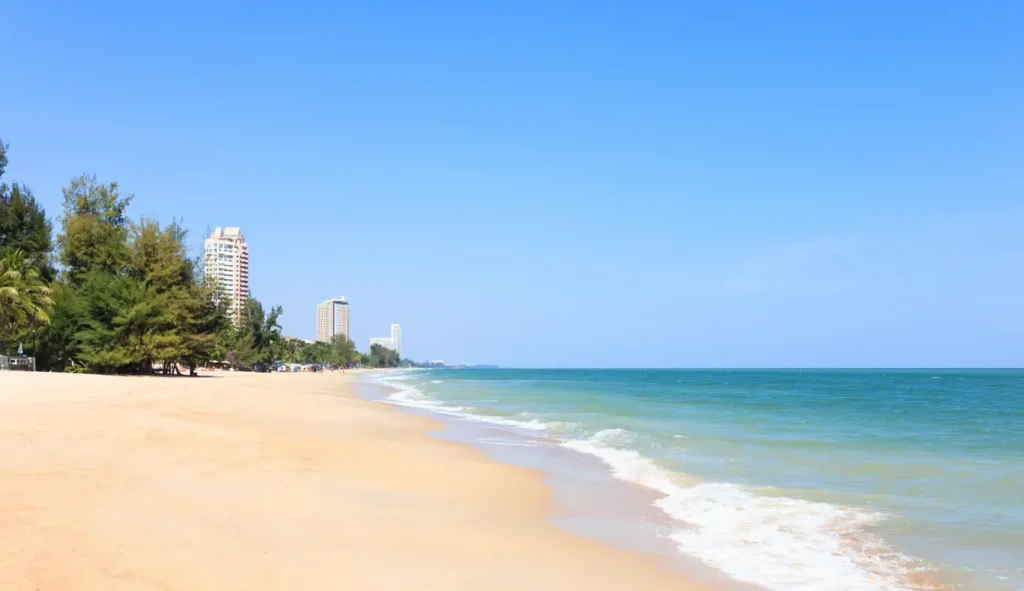
Located just north of central Hua Hin is the Cha-Am area, known for its Khiri Khan beach. This resort town boasts large beaches with powdery white sand and calmer waters. Additionally, the town is also home to plenty of beach resorts and quiet getaways, making it one of the best areas for families.
Fishing is a major industry in Cha-Am, which means you’ll likely come across fishing boats and fresh seafood for sale along the sandy stretch. There are several tourist destinations in the area, including the Royal Summer Home, the former home of King Rama VI, who ruled from 1910 to 1925.
While Cha-Am is a popular resort town, it lacks nightlife. There also aren’t that many restaurant options to choose from in Cha-Am. Even so, the local restaurants serve mouthwatering food at an affordable price.
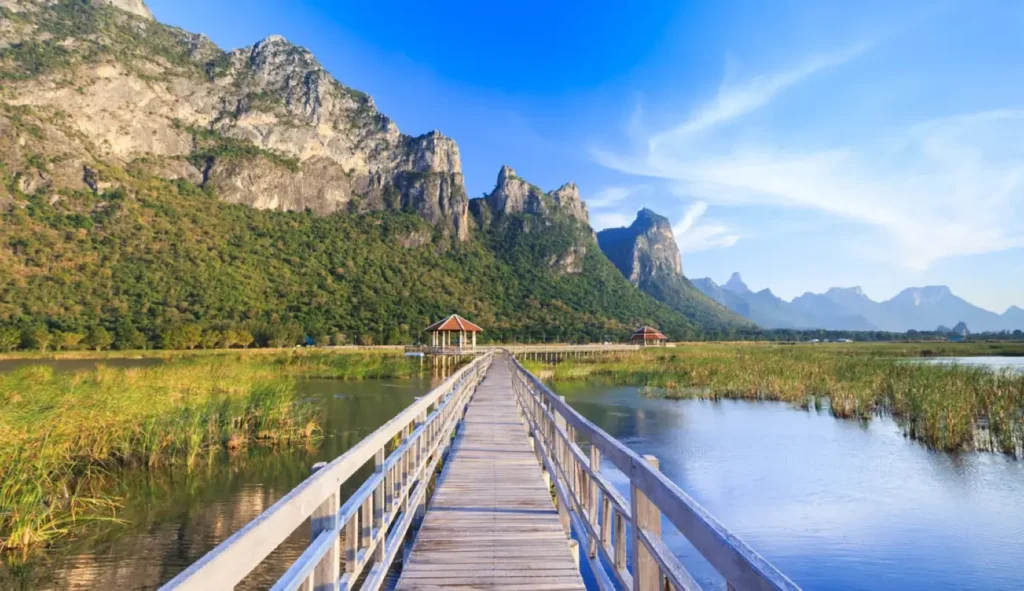
Located farther south of Hua Hin is another resort town called Pranburi. The area is extremely popular with tourists looking for a relaxed atmosphere and adventure travelers who plan to visit the nearby Khao Sam Roi Yot National Park.
While both Cha-Am and Pranburi are resort towns, the latter mostly boasts five-star resorts and private villas for luxury travellers. Pranburi also has some options for dining, nightlife, and shopping.
Pranburi is somewhat considered a “remote” area and is located 30 kilometres from central Hua Hin. This means you may need to consider renting a private car or hiring a private vehicle for the duration of your travel.
Located between central Hua Hin and Cha-Am, Bo Fai is a district often overlooked by tourists coming to Thailand. The district is not very tourist-oriented, with significantly fewer hotel and resort choices than in other areas. However, there are many condos and homes that offer short-term and long-term rentals. There are also plenty of bars and nightlife in the area, with the most popular being Rasta and Seven Something.
In addition to its bars and nightlife, there are also plenty of restaurants in the area, with the most popular being Aroi Sushi and Kraw Kuh Tho‘s night buffet.
Renting a condo is different from renting a hotel. When you rent condos or homes, you are required to fill up paperwork for the rental contract, pay for water and electricity charges you incur during your stay, and wash your clothes. In most cases, you also won’t have room cleaning service.
Hua Hin started off as a sleepy beach town but has since blossomed into a beautiful city by the sea. If you’re thinking of stopping by Hua Hin when visiting Thailand, here are some of the best attractions and things to do that you can add to your itinerary.
Thailand is a known food and shopping paradise. Everywhere you look and everywhere you go, you’re bound to be treated to the sights and scents of fresh seafood being grilled on coals and hot soup boiling in huge pots. Other markets in the city also offer a wide range of products and souvenirs, from clothing to accessories, and hand-made crafts to unique paintings.
Here are some of the best places to get food and shop:
Hua Hin is marked with possibly all of the colours of the rainbow, maybe even more. Some sights are bathed in golden hues that glitter under the sunlight. Other sights are surrounded by lush green trees, towering limestone walls, and cliffs.
Here are some of the best sights to explore:
If you want to get the full Hua Hin experience, you should consider visiting one of the many tourist sites where you’re treated to different kinds of thrills. Water parks, for example, make your blood rush with adrenaline. There’s always something for everyone in Hua Hin.
Wat Khao Lad – Wat Huay Mongkol – Royal Hua Hin Golf Course – Sanamchan Palace’s Royal Pavilion – Rajabhakti Park